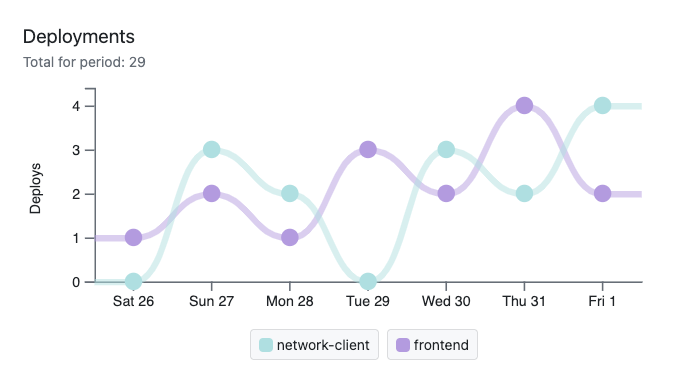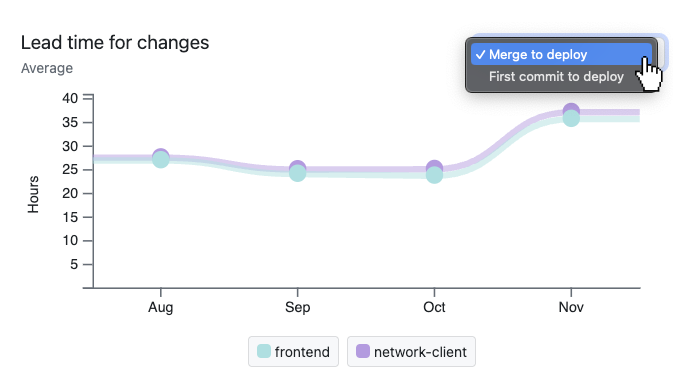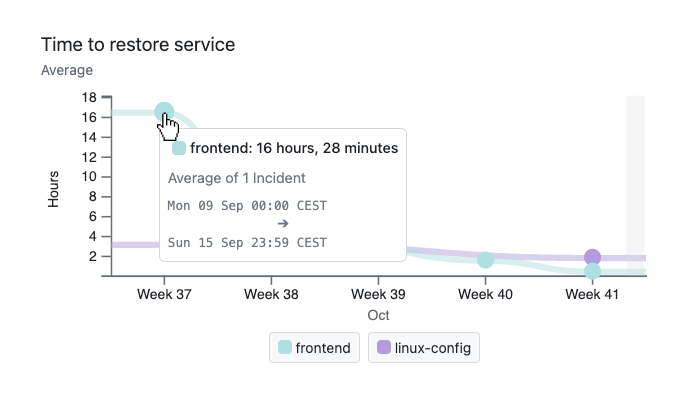Guide to DORA Metrics


I'm lucky enough to have been part of some amazing software teams. From developing core software inside PlayStation consoles (as part of Sony PlayStation's Advanced Technology Group), to building and running algorithmic trading systems in a multi-billion dollar hedge fund.
My goal is to help teams produce the best software possible, and enjoy themselves while they're doing it.
Efficiently delivering high-quality software has become crucial for companies of all sizes. DORA metrics can help with this. Developed by the DevOps Research and Assessment (DORA) team, these metrics let you analyze and improve your software development and delivery process. In this post I’ll define the metrics and explain their benefits for engineering managers and CTOs. I’ll also give tips for implementing the metrics in your organization.
What are DORA Metrics?
DORA metrics consist of four key indicators that measure the effectiveness of a software development team. They are:
- Deployment Frequency (DF)
- Lead Time for Changes (LTC)
- Change Failure Rate (CFR)
- Mean Time to Recovery (MTTR)
The metrics are careful chosen to balance each other. Focusing too much on one metric can cause the others to get worse. This means you need to track and improve all four metrics to get the benefits.
The great news is that optimizing the metrics is a reliable way to improve the software delivery performance of your organization. What’s more, the metrics are backed by research, and are relatively straightforward to implement.
Next, we’ll define each of the metrics and explain the benefit of tracking it.
Deployment Frequency (DF)

Deployment Frequency measures how often your team deploys code to production. This might range from multiple deployments each day to one deploy per month (or longer!).
Increasing your Deployment Frequency has these benefits:
- Faster Time-to-Market: Regular deployments mean new features and fixes reach customers quicker.
- Increased Agility: High DF allows for rapid response to market changes and customer feedback.
- Risk Mitigation: Smaller, more frequent updates reduce the risk of major failures.
Lead Time for Changes (LTC)
Lead Time for Changes tracks the time from committing code until that code is successfully running in production.

Some teams prefer to measure Lead Time for Changes as the time from a PR being merged until that PR is deployed. Ideally, your DORA tracking tools will let you see either option.
A lower Lead Time for Changes correlates with:
- Improved Productivity: Shorter lead times often indicate streamlined development processes.
- Better Planning: Understanding how long it takes to go from idea to production helps in accurate project forecasting.
- Enhanced Collaboration: Reducing lead time often requires cross-functional teamwork, promoting a collaborative culture.
Change Failure Rate (CFR)
Change Failure Rate measures the percentage of deployments that cause a failure in the production environment.

Fewer failures in production is obviously a good thing! It’s also important to have accurate failure numbers so you can see changes over time.
Other benefits of a Lower Change Failure rate include:
- Quality Assurance: A low CFR points to high-quality code and robust testing practices.
- Customer Satisfaction: Fewer failures mean a more stable and reliable product for users.
- Operational Efficiency: Lower failure rates result in fewer resources spent on firefighting and more on innovation.
Mean Time to Recovery (MTTR)
Mean Time to Recovery is the average time it takes to recover from a failure in the production environment.

You want this number to be as low as possible. A lower MTTR means:
- Resilience: Fast recovery times reflect a team’s ability to handle unexpected issues effectively.
- Improved Incident Management: Focusing on MTTR encourages developing efficient processes for diagnosing and rectifying issues.
- Increased Customer Trust: Minimizing downtime enhances customer trust and satisfaction.
Why Track DORA Metrics?
Enhanced Visibility
DORA metrics provide a clear, data-driven picture of how your development and operations processes are performing. This visibility is crucial for informed decision-making and strategic planning.
Foster Continuous Improvement
Regularly tracking these metrics encourages a culture of continuous improvement. Teams can identify bottlenecks and inefficiencies, thereby continuously refining their practices.
Benchmark Against Industry Standards
DORA metrics allow you to benchmark your team’s performance against industry standards. This is invaluable for understanding where you stand compared to your peers and which areas need to improve.
Promote a Healthy Culture
Focusing on these metrics helps build a culture that values efficiency, quality, and customer satisfaction. It encourages teams to take ownership of their work and strive for excellence.
Implementing DORA Metrics in Your Organization
Check out our guide on implementing DORA metrics.
Want to Learn More?
The book Accelerate: The Science of Lean Software and DevOps: Building and Scaling High Performing Technology Organizations by Nicole Forsgren, Jez Humble and Gene Kim is highly recommended. It contains many real-world examples of the methods and benefits of tracking DORA metrics.
What’s more, the authors co-founded the DevOps Research and Assessment organization which developed the DORA metrics, so they write on the subject with great authority and experience.
Conclusion
DORA metrics are a reflection of your team’s ability to deliver high-quality software efficiently. By understanding and effectively tracking these metrics, engineering managers and CTOs can drive significant improvements in their software development processes, ultimately leading to a stronger, more competitive business.
The goal is not to just track these metrics, but to use them as a guide for continual refinement and improvement in your software delivery process.
Need help getting started with DORA?
Get an hour of free consultancy and kickstart the implementation of DORA Metrics in your organization.
- Get two 30 minute video calls with an expert on DORA Metrics.
- Receive specific and actionable advice for your organization.
- Benefit from our experience of introducing DORA Metrics in companies of all sizes.
- Completely free, and no obligations.
